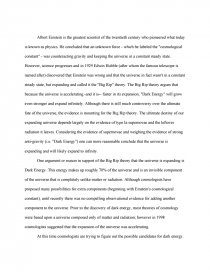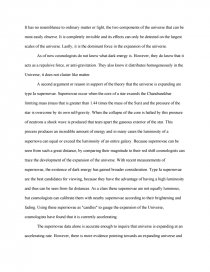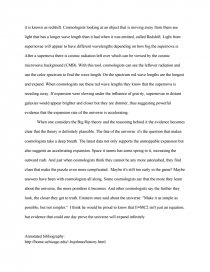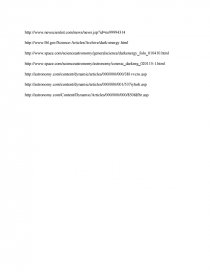The Expandng Universe
Essay by review • January 3, 2011 • Essay • 982 Words (4 Pages) • 1,096 Views
Albert Einstein is the greatest scientist of the twentieth century who pioneered what today is known as physics. He concluded that an unknown force - which he labeled the "cosmological constant" - was counteracting gravity and keeping the universe in a constant steady state. However, science progresses and in 1929 Edwin Hubble (after whom the famous telescope is named after) discovered that Einstein was wrong and that the universe in fact wasn't in a constant steady state, but expanding and called it the "Big Rip" theory. The Big Rip theory argues that because the universe is accelerating -and it is-- faster in its expansion, "Dark Energy" will grow even stronger and expand infinitely. Although there is still much controversy over the ultimate fate of the universe, the evidence is mounting for the Big Rip theory. The ultimate destiny of our expanding universe depends largely on the evidence of type Ia supernovae and the leftover radiation it leaves. Considering the evidence of supernovae and weighing the evidence of strong anti-gravity (i.e. "Dark Energy") one can more reasonable conclude that the universe is expanding and will likely expand to infinity.
One argument or reason in support of the Big Rip theory that the universe is expanding is Dark Energy. This energy makes up roughly 70% of the universe and is an invisible component of the universe that is completely unlike matter or radiation. Although cosmologists have proposed many possibilities for extra components (beginning with Einstein's cosmological constant), until recently there was no compelling observational evidence for adding another component to the universe. Prior to the discovery of dark energy, most theories of cosmology were based upon a universe composed only of matter and radiation; however in 1998 cosmologists suggested that the expansion of the universe was accelerating.
At this time cosmologists are trying to figure out the possible candidates for dark energy. It has no resemblance to ordinary matter or light, the two components of the universe that can be most easily observe. It is completely invisible and its effects can only be detected on the largest scales of the universe. Lastly, it is the dominant force in the expansion of the universe.
As of now cosmologists do not know what dark energy is. However, they do know that it acts as a repulsive force, or anti-gravitation. They also know it distributes homogeneously in the Universe; it does not cluster like matter.
A second argument or reason in support of the theory that the universe is expanding are type Ia supernovae. Supernovae occur when the core of a star exceeds the Chandrasekhar limiting mass (mass that is greater than 1.44 times the mass of the Sun) and the pressure of the star is overcome by its own self-gravity. When the collapse of the core is halted by this pressure of neutrons a shock wave is produced that tears apart the gaseous exterior of the star. This process produces an incredible amount of energy and in many cases the luminosity of a supernova can equal or exceed the luminosity of an entire galaxy. Because supernovae can be seen from such a great distance, by comparing their magnitude to their red shift cosmologists can trace the development of the expansion of the universe. With recent measurements of supernovae, the existence of dark energy has gained broader consideration. Type Ia supernovae are the best candidates for viewing, because they have the advantage of having a high luminosity and thus can be seen from far distances. As a class these supernovae are not equally luminous, but cosmologists can calibrate them with nearby supernovae according to their brightening and fading. Using these supernovae as "candles" to gauge the expansion of the Universe, cosmologists have found that it is currently accelerating.
The supernovae data alone is accurate enough to inquire that universe is expanding at an accelerating rate. However, there is more evidence pointing towards an expanding universe and it is known as redshift. Cosmologists looking at an object that is moving away from them see light that has a longer wave length
...
...



